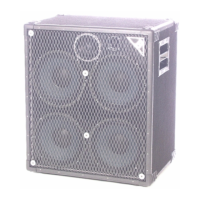noticeable before. Or, your pickups might exhibit a “peakiness” that hadn’t been noticeable when used
Distortion, when introduced by any part of a sound system, will be heard from the speaker. If, for
ier has a weak tube, the effects of that weakness will be heard as distortion
. Sometimes, then, to say “the spe
aker is distorting,” can present a false picture.
A couple of gents had their Low B speaker disassembled before they realized t
hat their effects processor
had a low battery. Another fellow sent frantic email asking help in diagnosing his faulty speaker, b
realizing the battery in his bass was nearly spent, and he hadn’t noticed with his old speaker. A new
The point, then, is that when you hear distortion, you must isolate the cause of it. If your instrument is at
a chain, and your speaker is the other end, distortion occurs when any link in the chain is
ent is to expose it to an input signal of sufficient strength to exceed
Sometimes, when faced with a speake
r of lower efficiency, such as the Low B systems, a player will,
without thinking, boost the volume control on his/her instrumen
t to compensate. To do this though, is to
risk overdriving the preamplifier, by exceeding it’s input capability. Similarly, to t
to levels that would try to squeeze 200 watts from a 100 watt amplifier is to (over)drive the amplifier i
distortion. To push 1000 watts into a 500 watt speaker will obviously overdrive the speaker.
So, having explained that, if
you hear distortion, proceed as follows:
Increase the volume setting on your power amp, if you have one. Compensate by dec
If distortion persists, increase the setting on your preamp’s volume control,
decreasing the setting on your instrument’s volume control.
If distortion persists, check all of your batteries, an
If distortion persists, and you’re not playing very loud, you mi
you’re playing quite loud, you might have too much
power, and could be overdriving the speaker (Ye
If distortion persists, call Acme, and we’ll talk about it.
The midrange attenuator, while rugged and generally quite nice, can have a “scratchiness” if you listen
the control. Don’t be alarmed. This isn’t a sign of a defect. That’s just the way they
are. I believe it’s as a result of a manu
facturing residue of some kind, as it tends to go away as the
attenuators are adjusted repeatedly.
speakers is crossed over at a very high frequency. In some circumstances, there will
very little output from the tweeter, becau
se there will be no substantial signal from the instrument in the
high harmonics. This has led to the conclusion by some th
at their tweeter is either blown or

